Click on images to enlarge
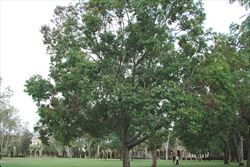
habit (Photo: Sheldon Navie)

trunk with rough lower bark and smooth upper bark (Photo: Sheldon Navie)

new growth (Photo: Sheldon Navie)
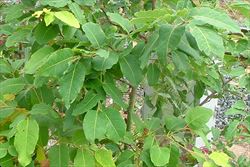
leaves (Photo: Sheldon Navie)
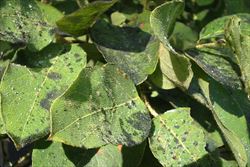
older leaves covered with sooty mould (Photo: Sheldon Navie)
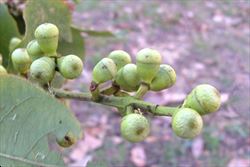
flower buds (Photo: Sheldon Navie)
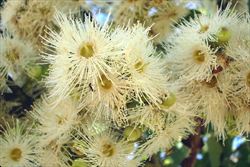
flowers (Photo: Sheldon Navie)
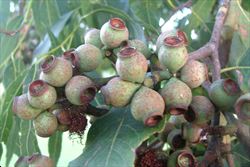
immature fruit (Photo: Sheldon Navie)
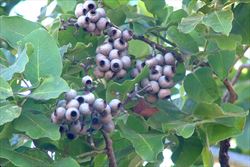
leaves and clusters of mature fruit (Photo: Sheldon Navie)
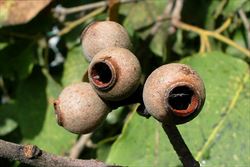
close-up of mature fruit (Photo: Sheldon Navie)
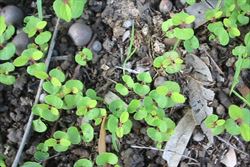
young seedlings (Photo: Sheldon Navie)
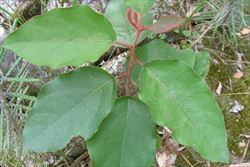
older seedling with reddish hairs (Photo: Sheldon Navie)
Scientific Name
Corymbia torelliana (F. Muell.) K.D. Hill & L.A.S. Johnson
Synonyms
Eucalyptus torelliana F. Muell.
Family
Myrtaceae
Common Names
cadaga, cadaghi, cadaghi gum, cadagi, cadagi tree
Origin
Native to the rainforests of northern Queensland (i.e. on the Atherton Tablelands).
Cultivation
Widely cultivated as a street and garden tree in the tropical and sub-tropical regions of Australia.
Naturalised Distribution
Naturalised beyond its native range in south-eastern and central Queensland.
Habitat
It is a weed of roadsides and waterways, disturbed sites, waste areas, and open woodlands in the sub-tropical regions of Australia (particularly in areas that are close to habitation).
Habit
A large tree growing up to 30 m in height.
Distinguishing Features
- a large tree with rough bark on the lower part of the trunk and smooth greyish-green bark on the upper part of the trunk.
- the leaves are relatively large, broad, and roughly hairy (unlike most other eucalypts).
- its leaves are often affected by a sooty mould which produces distinctive black sooty deposits on the leaf blades.
-
its white flowers are borne in large clusters at the tips of the branches and have numerous stamens.
-
its woody capsules (9-13 mm long and 10-14 mm wide) are rounded or urn-shaped and have three compartments.
Seedling
The two seed leaves (i.e. cotyledons) are almost rounded in shape (i.e. sub-orbicular) or kidney-shaped (i.e. reniform). The stem and leaf stalks of the seedlings are usually densely covered in reddish hairs.
Stems and Leaves
The bark on the lower part of the trunk is persistent, rough, and dark brown or reddish-brown in colour (i.e. fibrous and/or scaly like a bloodwood). The remainder of the trunk has smooth bark that is often shed in strips. This bark is initially greenish or greyish-green in colour but after being exposed for some time it turns grey in colour. The spreading branches are borne at almost right angles to the main trunk and younger stems can usually covered in short reddish or whitish hairs (i.e. they are pubescent).
The leaves on young plants (i.e. juvenile leaves) are oppositely or alternately arranged with broadly egg-shaped (i.e. ovate) leaf blades (up to 20 cm long and 11 cm wide). They have pointed or rounded tips (i.e. acute or obtuse apices) and rounded to heart-shaped (i.e. obtuse to cordate) bases. The leaf blades and leaf stalks (i.e. petioles) can be rough to touch (i.e. scabrous) because of a covering of tough short hairs. The adult leaves are not that much different from the juvenile leaves. They are alternately arranged, egg-shaped in outline (i.e. ovate) and taper to a point (i.e. acute apex). These leaves (7.5-16 cm long and 1.8-3.5 cm wide) have a wedge-shaped (i.e. cuneate) or asymmetrical base.
Flowers and Fruit
The white flowers are borne in small groups (of 3-7 flowers) that are arranged into larger clusters at the tips of the branches (i.e. in terminal panicles). The flower buds (7-12 mm long) are oval (i.e. ellipsoid) to egg-shaped (i.e. ovoid) and smooth. They have a hemispherical ‘lid’ (i.e. operculum or calyptra) that is shed when the flower opens. Each flower has a swollen base (i.e. hypanthium), numerous white or cream coloured stamens, and a central style topped with a small stigma. Flowering occurs mostly during spring.
The fruit are woody capsules (they are not 'nuts') that contain many small seeds. These fruit (9-13 mm long and 10-14 mm wide) are rounded (i.e. globular) or urn-shaped (i.e. urceolate) with three compartments. They turn from green to grey or brown in colour as they mature. The seeds are egg-shaped (i.e. ovoid), kneecap-shaped (i.e. patelliform) or somewhat flattened and red or reddish-brown in colour.
Reproduction and Dispersal
This species reproduces by seed. Seeds are spread by wind, water, native bees, and in dumped garden waste.
Environmental Impact
Cadaghi (Corymbia torelliana) is regarded as an environmental weed in south-eastern Queensland and as a potential environmental weed in New South Wales. It is becoming a serious weed in Queensland, where native bees collect its resin-coated seeds and spread it into eucalypt forests all over south-eastern Queensland.
This species has a very dense canopy of large leaves that is well suited to the rainforests of northern Queensland. When growing in open woodlands, outside its native range, it creates a heavy shade over the native understorey plants and prevents them from growing. It therefore has a significant potential to modify the diversity and structure of the native forests in sub-tropical Australia.
Other Impacts
The sticky resin from the fruiting capsules is collected by native stingless bees (e.g. Trigona carbonaria) and can completely clog the honeycombs and sometimes also seal the bee hive entrance, killing all the bees inside. This tree often gets covered in a sooty fungus, which can dirty or discolour things that are underneath it (e.g. vehicles, pavers and outdoor furniture). The large horizontal limbs are also prone to snapping off and damaging property.
Legislation
Not declared or considered noxious by any state government authorities.

